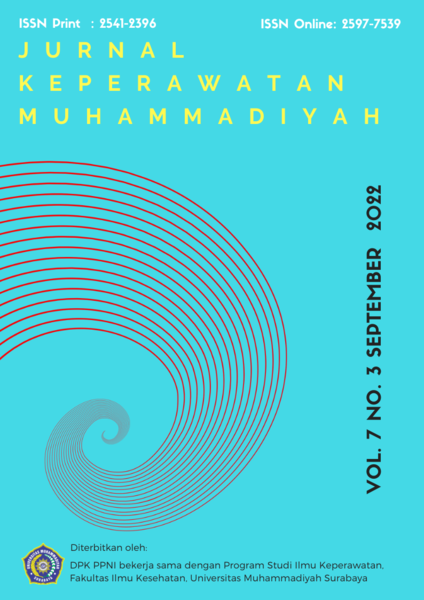Analisis Pengaruh Pola Konsumsi Makanan Pemberian Asi Dan Kesehatan Lingkungan Terhadap Status Gizi Balita Di Wilayah Kerja Puskesmas Mekarsari Lebak Propinsi Banten
DOI:
https://doi.org/10.30651/jkm.v7i3.13500Keywords:
Toddler Comsumption Pattern, Environmental Health, Nutritional status of toddlersAbstract
Background :. The problem of undernutrition and malnutrition is still a major problem in Indonesia. Malnutrition if allowed to continue to develop has an impact on brain development. Initial observations of researchers still found toddlers who were under the red line, had difficulty eating conditions, were breastfed and an environment that relatively did not meet health requirements. Researchers are interested in further analyzing the nutritional status of children under five, feeding patterns and environmental health in the working area of PKM Mekarsari.Purpose of Writing: To determine the pattern of feeding, breastfeeding and environmental health on the nutritional status of children under five in the working area of the Mekarsari Public Health Center, Tangerang Regency in 2021.
Research Methods: The design of this research is correlational descriptive with a cross sectional approach. The population is all children aged 12-60 months who are in the working area of the Mekarsari Public Health Center as many as 335 toddlers, for this study a sample of 182 toddlers was taken, using simple random sampling technique. Data were analyzed using univariate, bivariate and multivariate analysis with regression and correlation tests. Research Results: The results of the univariate analysis showed that most of the toddlers (45%) had a good diet, but breastfeeding (45%) was relatively lacking, the environmental health level of 45% was relatively good, the results of multivariate bivariate analysis showed eating patterns and then breastfeeding. and environmental health show that there is an influence on the nutritional status of children under five in the Mekarsari working area
Conclusions and Suggestions: the results of the study show that there are still toddlers with poor nutritional status, it is hoped that the Mekarsari Health Center can provide more services to families who have children under five and can prioritize promotive and preventive primary services through IEC activities or health counseling in order to improve health status. community, especially in improving the nutritional status of children under five by reducing and suppressing the incidence of malnutrition or malnutrition
References
Adiputra, I. made S. (2021). Metodologi Penelitian Kesehatan. Yayasan Kita Menulis.
Asnuddin, A., & Hasrul, H. (2019). Analisis pola asuh keluarga terhadap status gizi balita. Jurnal Kebidanan Dan Keperawatan Aisyiyah, 15(1), 37–48. https://doi.org/10.31101/jkk.1001
Camci, N., Bas, M., & Buyukkaragoz, A. H. (2014). The psychometric properties of the Child Feeding Questionnaire (CFQ) in Turkey. Appetite, 78, 49–54. https://doi.org/10.1016/J.APPET.2014.03.009
Damanik, E. S. D. (2018). Hubungan pola asuh orang tua dengan kesulitan makan pada anak usia 3-5 tahun di desa Sukaraya Kecamatan Pancur Batu tahun 2018. Skripsi, 1–76.
Daulay, S. N. (2017). Gambaran Sanitasi Lingkungan Dan Personal Hygiene Ibu Dengan Kejadian Diare Pada Balita Di Wilayah Kerja Puskesmas Tanjung Tiram Kabupaten Batu Bara Tahun 2017 [Universitas Sumatera Utara]. https://repositori.usu.ac.id/bitstream/handle/123456789/1656/131000228.pdf?sequence=1&isAllowed=y
Dwiwardani, R. L. (2017). Analisi Faktor Pola Pemberian Makan Pada Balita Stunting Berdasarkan Teori Transcultural Nursing [Univeristas Airlangga]. https://repository.unair.ac.id/77640/2/full%20text.pdf
Hidayat, T. S., & Fuada, N. (2013). Relationship between environmental sanitation, morbidity and nutritional status of under-five children in indonesia. Penelitian Gizi Dan Makanan, 34(2), 104–113.
Kemenkes. (2020). Peraturan Menteri Kesehatan Republik Indonesia. In Peraturan Menteri Kesehatan Republik Indonesia.
Khasanah, V. N. (2018). Analisis Faktor Yang Berhubungan Dengan Pemberian Asi Eksklusif Oleh Ibu Pekerja Pabrik Di Wilayah Puskesmas Kalirungkut Surabaya [Universitas Airlangga]. https://repository.unair.ac.id/85198/4/full%20text.pdf
Lestari, N. D. (2015). Analisis Determinan Status Gizi Balita di Yogyakarta. Mutiara Medika: Jurnal Kesehatan Dan Kedokteran, 15(1), 21–27.http://journal.umy.ac.id/index.php/mm/article/view/2490
Ningsih, I. D. (2013). Hubungan kesehatan lingkungan terhadap status gizi anak prasekolah di kelurahan semanggi dan sangkrah kecamatan pasar kliwon surakarta. Universitas muhammadiyah surakarta.
Normayanti, N., & Susanti, N. (2013). Status pemberian ASI terhadap status gizi bayi usia 6-12 bulan. Jurnal Gizi Klinik Indonesia, 9(4), 155. https://doi.org/10.22146/ijcn.18362
Pane, A. I. S. (2019). Pengaruh Kesehatan Lingkungan Terhadap Resiko Stunting Pada Anak di Kabupaten Langkat SKRIPSI. 33–35.
Prakhasita, R. C. (2018). Hubungan Pola Pemberian Makan Dengan Kejadian Stunting pada Balita Usia 12-59 Bulan di Wilayah Kerja Puskesmas Tambak Wedi Surabaya. Skripsi, 1–119.
Rasmaniar, Rahayu, E. S., Sumardi, R. N., HAsanah, L. N., Atmaka, D. R., Alfiah, E., Pasaribu, R. D., & Pattola. (2021). Pengantar Kesehatan dan Gizi (J. Simarmata, Ed.; 1st ed., Vol. 1). Yayasan Kita Menulis. https://books.google.co.id/books?hl=en&lr=&id=-jJAEAAAQBAJ&oi=fnd&pg=PA1&dq=buku+pengantar+ilmu+gizi&ots=0tWs18Y-44&sig=xSPME2zfkBEbS99l7qluqAfWs9c&redir_esc=y#v=onepage&q=buku%20pengantar%20ilmu%20gizi&f=false
Susanti, M. (2018). Faktor-Faktor yang Berhubungan Dengan Status Gizi Balita di Kelurahan Bumijo Kecamatan Jetis Kota Yogyakarta Tahun 2017. In Skripsi.
Wiji, R. (2013). Asi dan panduan menyusui. Yogyakarta: Nuha Medika.
Downloads
Published
Issue
Section
License
- Penulis tetap memegang hak atas karyanya dan memberikan hak publikasi pertama kepada jurnal ini yang secara simultan karya tersebut dilisensikan di bawah:Â Creative Commons Attribution-ShareAlike 4.0 International (CC BY-SA 4.0)













